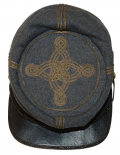site search
online catalog
MAJOR TO GENERAL'S CAP OF ROBERT F. HOKE

$35,000.00
Quantity Available: 1
Item Code: 1268-1010
Shipping: Determined by Method & Location of buyer
To Order:
Call 717-334-0347,
Fax 717-334-5016, or E-mail
This superb kepi was previously owned by well-respected individuals including Mr. Richard Abel, Mr. Shannon Pritchard and Mr. Ray Richey owner and operator of the Texas Civil War Museum. We have the privilege of now being able to offer it.
Born in North Carolina, Robert Frederick Hoke graduated from the Kentucky Military Institute in 1854. When the Civil War began, he enlisted in the 1st North Carolina Infantry, where he received a commission as a second lieutenant. After the Battle of Big Bethel, he received a promotion to major of the 33rd North Carolina. He fought through the Peninsula Campaign, the Seven Days, Chancellorsville, Second Manassas, and Antietam. He was promoted to brigadier general on January 17, 1863, and commanded a brigade at 2nd Fredericksburg (Chancellorsville campaign), where he was severely wounded. After he recovered from his wounds, Hoke led a brigade to North Carolina, where he participated in the battles of New Bern and Plymouth. At the Battle of Plymouth, Hoke captured a garrison of three thousand Union soldiers and was promoted to major general on April 20, 1864. Back in Virginia Hoke led a division at Cold Harbor. He and his division were once again sent to North Carolina after the battle, where he participated in the defense of Fort Fisher, the Carolina Campaign, and finally at the Battle of Bentonville, where his gallantry was noted. He finally surrendered to Union forces with Johnston's army in April of 1865. After the war, he entered the development of iron mines and was named a director of the North Carolina Railroad Company, in 1893. He died in 1912.
This kepi is of the chasseur pattern. The sides and top are made of a cadet gray broadcloth. The band at the base of the cap is a black broad cloth the prescribed color for infantry by North Carolina. The kepi is 3 inches high in front, and it rises to 6 and 5/8 inches toward the back. The top disc is 5 1/8 inches in diameter. The cap is trimmed in 3/16-inch soutache braid made of flat gold foil. Three strands of braid run up the front, back and sides of the cap. A single strand runs around the edge of the top "cookie" and inside three strands are set in the "quatrefoil" shape. On the black bottom band three strands originally ran but a fourth strand was later added and is basted in place. This fourth stand is not as firmly applied and shows a different sewing hand then the other three and it was certainly added to the cap when Hoke made brigadier general in January of 1863. About 15% of the top of the cap shows professional restoration to damage caused by insects. Done by Textile Preservation Services of Texas the work is difficult to detect at first glance. The visor on the cap is bound Patent leather and is 1 1/2 inches deep. The chinstrap is black Patent leather and is held in place by two "SCOVILL" eagle staff officer's buttons and they appear to be sewn in place at the time of use. The cap is lined inside with what appears to be a polished or glazed cotton. This rises to the blackened (waterproofing) disc. The sweatband is a brown Morrocco leather 1 5/8 inches high with a tooled line about 1/8 of an inch from its raw edge. The sweat band is 100% intact but were torn in a couple of spots has been re-enforced. In period ink on the brown cotton lining just above the sweatband is "R.F. Hoke". When compared to General Hoke's signature this is a match. Also glued on the crown of the cap is a faded tag measuring 4 inches by 1 1/2 inches that reads, "Gen. Hoke's Kepie (sic) Fredericksburg." It is very probable that this label was displayed outside the cap for decades thereby resulting in its fading. We know Hoke was severely wounded at second Fredericksburg and this tag indicates he was wearing the cap at that time. If he wore it after his wounding one can only speculate.
Included with the cap is a letter of observation by authority Mr. Les Jensen dated December 20th, 2004. His conclusion reads: "Based strictly on observation with the naked eye and a 10-power hand lens, and experience examining many Confederate kepis over roughly thirty years, there is nothing to indicate that this is not an original Civil War period kepi. The color combination and the materials are perfectly acceptable for a North Carolina officer." Subsequently the highly respected dealer and scholar Shannon W. Pritchard of Old South Military Antiques conducted forensic testing on this cap prior to him, Shannon, selling it to Mr. Ray Richey. His conclusion: "The research that included HPLC dye analysis and microscopic analysis of yarns and fibers evidence supports the idea that this is both old materials (pre-1880) with one old world dye identified in samples taken from a General Robert Hokes Cap" (sic). The Jensen report, the Pritchard report and the Textile Preservation Services of Texas treatment report will pass to the purchaser of this most historic cap. [pe][ph:L]
~~~~~~~~~~~~~~~~~~~~~~~~~~~~~~~~~~~
THIS ITEM, AS WITH ALL OTHER ITEMS AVAILABLE ON OUR WEB SITE,
MAY BE PURCHASED THROUGH OUR LAYAWAY PROGRAM.
CLICK HERE FOR OUR POLICIES AND TERMS.
THANK YOU!
Inquire About MAJOR TO GENERAL'S CAP OF ROBERT F. HOKE
For inquiries, please email us at [email protected]
Most Popular
Historical Firearms Stolen From The National Civil War Museum In Harrisburg, Pa »
Theft From Gravesite Of Gen. John Reynolds »
Selection Of Unframed Prints By Don Troiani »
Fine Condition Brass Infantry Bugle Insignia »
British Imported, Confederate Used Bayonet »
Scarce New Model 1865 Sharps Still In Percussion Near Factory New »
featured item
MAJOR TO GENERAL'S CAP OF ROBERT F. HOKE
This superb kepi was previously owned by well-respected individuals including Mr. Richard Abel, Mr. Shannon Pritchard and Mr. Ray Richey owner and operator of the Texas Civil War Museum. We have the privilege of now being able to offer it. Born in… (1268-1010). Learn More »
site search
Upcoming Events
May 16 - 18: N-SSA Spring Nationals, Fort Shenandoah, Winchester, VA Learn More »













